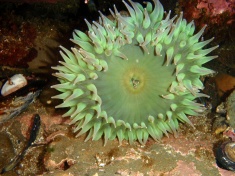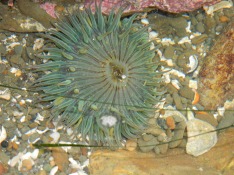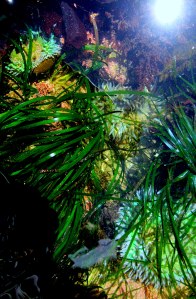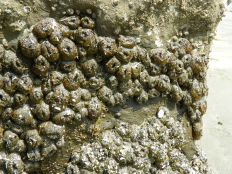Sea anemones are unique and vibrant animals. No, that wasn’t a typo – they ARE animals! Some people may think they are underwater flowers when they see them, but they do not photosynthesize (create energy from the sun) like plants do. Instead, they consume other living things, like all animals. They belong to the phylum, or grouping of animals, called Cnidarians. Other cnidarians you may have heard of are things like sea jellies and corals. To learn the fascinating physiology of anemones, we can start at the base.
The bottom of an anemone is called the pedal disc. A pedal disc has a thin tissue plate that is used to help adhere to hard substrates such as rocks. Moving up the body (or the “column”), we encounter the acontia, which are thread-like organs that consist of nematocysts (the special stinging cells used to catch its food).
Higher inside the column, the acontia become mesenterial filaments that aid with digestion. Within the body are gametogenic tissues (gonads), which are the organs responsible for reproduction. The pharynx is right behind the mouth and is kind of like a throat that leads to the gastrovascular cavity, or the anemone version of a stomach. As we know, what goes in, must also come out and for anemones, there is only one way in or out. As gross as it may sound, the oral disc is also the anus. That’s nature! Above the pharynx are hair-like grooves known as siphonoglyph that help to create water currents into the pharynx. On the top of anemones are the tentacles that help to paralyze and grab food.
There are many types of anemones around the world. For those of us that live on the California coast, there are three species that you can find in our local tidepools.
A. elegantissima, known as the aggregating anemone, has radiating lines on the oral disk. The tentacles can be greenish to pinkish and the column can be covered in small shell fragments. This adaptation can make them difficult to spot. When people explore the tidepools, they sometimes do not realize they are stepping on living organisms! A. elegantissima are able to clone. Each aggregated group of clones like to have their space and will have “clone wars” if their territory is threatened. May the Force be with you!
Our next two Anthopleura spp. are sometimes hard to distinguish from one another. Let’s learn a little more about the differences and you will be a master at finding each species on your next tidepool adventure. A. sola, the sunburst anemone, has longer and thinner tentacles than its counterpart, A. xanthogrammica. A. sola also has distinctive radiating lines on the oral disc. A. xanthogrammica oral disc lacks radiating lines and is normally some shade of green.


Next time you venture to the coast and delve into the rocky intertidal habitat, make sure to see what is under your feet, it could be an anemone!
References:
Edited by KC O’Shea
Photos: MSI
http://oceanservice.noaa.gov/education/kits/corals/coral01_intro.html
http://www.eeb.ucsc.edu/pacificrockyintertidal/target/target-species-anthopleura.html


